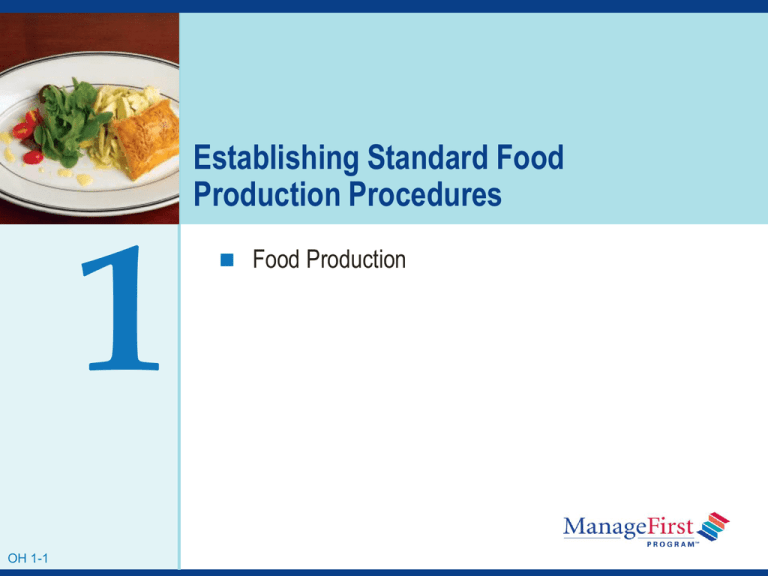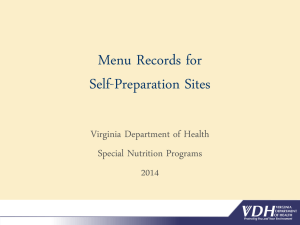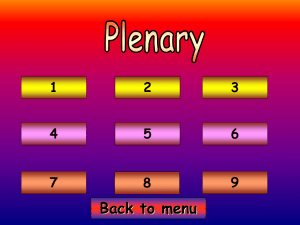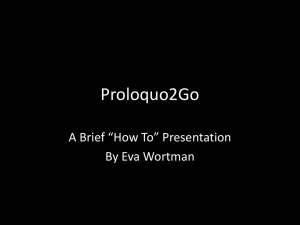Establishing Standard Food Production Procedures
advertisement

Establishing Standard Food Production Procedures 1 OH 1-1 1-1 Food Production Chapter Learning Objectives Explain the importance of standards for and procedures to control production volume. Describe standard procedures to help managers control production volume. Describe methods to gather data for sales histories. Review knowledge and skill levels needed by food production employees. OH 1-2 Standards for Controlling Production Volume Operations must have standard procedures to produce menu items. Food production standards help ensure that customers receive the same quality of food on each visit. Food production standards are typically created by managers and chefs. OH 1-3 More About Production Volume Standards to control production volume allow the operation to produce food in correct quantities at a specified level of quality. OH 1-4 Production Volume Control Tool: Standardized Recipe A list of ingredients and quantities needed to produce a menu item including methods for production and required portion size OH 1-5 Standardized Recipe If this recipe is carefully followed, it will yield fifty portions (one and a half cup each) of squash risotto that meet the quality standards of the operation. OH 1-6 Review of Information for Standardized Recipe Ingredient details Time required Correct weights and Storage and Equipment and tools Cooking methods measures of ingredients needed Production volume OH 1-7 preparation information Production Volume Control Tool: Product Specification Sheet A list of the descriptions of characteristics required for an item to meet standards Purposes Ensures and controls quantity, quality, and cost Avoids misunderstandings between the operation and its suppliers Serves as the basis for bid writing OH 1-8 Product Specification Sheets OH 1-9 Production Volume Control Tool: Menu Description A description of the ingredients, portion size, and size count in a menu item Menu descriptions help kitchen staff, servers, and managers. OH 1-10 Menu Descriptions OH 1-11 Production Volume Control Tool: Preparation Sheet Sets standards for basic items required in the establishment Par levels indicate the quantity of items needed for a specific item based upon the day’s estimated sales. OH 1-12 Preparation Sheet OH 1-13 How Would You Answer the Following Questions? OH 1-14 1. Ingredients and quantities needed for a menu item are found in a _______. 2. Quality requirements for specific ingredients are found in a _______. 3. A review of standards for an entire menu item is found in a _______. 4. A _______ includes the par levels of items required in an establishment. Standard Operating Procedures (SOPs) Control Production Volume Planning begins the previous day by using sales histories to forecast estimated number of servings. Recipes are converted to appropriate yields. Prep sheets are developed to determine portions needed and required par levels. OH 1-15 Before Production Begins These busy cooks are preparing items specified on the preparation sheet. OH 1-16 Production Volume Control Tools in Action Product specification sheets Spot checks help assure that ingredient quality standards are met. Preparation sheets Help assure that par levels for basic items are available Standardized recipes Help assure that quality requirements will be attained Menu descriptions Help assure that food items meet standards when served to customers OH 1-17 Production Volume Control Tools and New Menu Items Standardized recipes are created first. Specification sheets (for purchasing) and preparation sheets (for daily operational planning) are developed. Menu descriptions help assure that foods served meet standards. OH 1-18 Daily Operations OH 1-19 Sales History and Forecasting Profitable food production requires correct forecasting. Forecasting yields the estimated number of guests to be served. The number of guests to be served provides information for preparation sheets. OH 1-20 Sales History Information: Point-of-Sale (POS) Systems After a guest order is placed in the system, multiple types of information can be generated. POS systems can track orders by hour, shift, or other bases so guest count, staffing, and equipment usage can be assigned. OH 1-21 Server Input of Customer Orders In properties using manual check systems, servers may input orders into cash registers. Daily sales information from cash register reports can be used to develop sales histories. OH 1-22 Food Production Knowledge and Skills The production team must have a variety of specialized skills at several stages in the flow of food. Preparing Cooking Holding Cooling Reheating OH 1-23 Production Knowledge and Skills Stage Beginner Preparing Cleaning, cutting vegetables OH 1-24 Intermediate Advanced Prepping line items, which are more expensive Working on special menu items Production Knowledge and Skills continued OH 1-25 Stage Beginner Intermediate Advanced Cooking Following standardized basic recipes for simple production, for example stocks Following standardized recipes for more complex dishes, for example sauces Creating and following standardized recipes Production Knowledge and Skills continued Stage Beginner Holding, Follow proper cooling, sanitary reheating standard procedures OH 1-26 Intermediate Advanced Follow proper sanitary standard procedures; acts as role model for beginners Develop HACCP program or sanitation SOPs How Would You Answer the Following Questions? OH 1-27 1. Managers should create _______ procedures to guide activities performed by employees while doing their jobs. 2. When a new menu item is planned, the first thing created is a _______. 3. Forecasting predicts the number of guests an operation will serve in a given time period. (True/False) 4. Cleaning and cutting vegetables is an example of the _______ stage in the flow of food. Key Term Review Back-of-the-house Par level Conversion Plating Forecasting Point-of-sale (POS) Front-of-the-house OH 1-28 system Portion size Key Term Review continued Prep sheet Product specification sheet Production volume Sales history OH 1-29 Standard operating procedure (SOP) Standardized recipe Yield Chapter Learning Objectives— What Did You Learn? Explain the importance of standards for and procedures to control production volume. Describe standard procedures to help managers control production volume. Describe methods to gather data for sales histories. Review knowledge and skill levels needed by food production employees. OH 1-30






